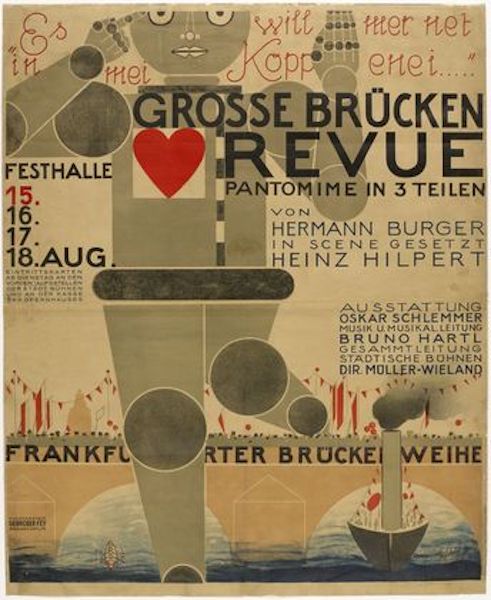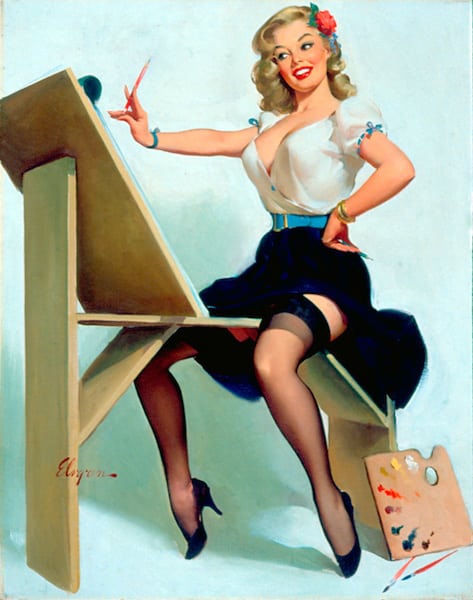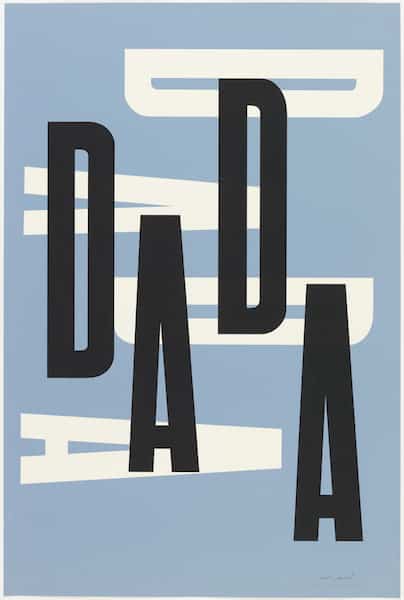
Jacques Villegle – Boulevard Haussmann, 1988.
Over the course of history, art has always been closely linked to social context. From the ancient elitism to contemporary democratization, it appeared in many different forms, complementing, commenting, protesting and commemorating social and political circumstances. In this continuing evolution, there are some art forms that stood out more than others from the perspective of social engagement, availability, and impact. One of the most prominent and influential art creations in this group is definitely a poster.
The history of poster art is closely linked to histories of advertising and graphic design, although this mode of expression has always been susceptive to particular art styles of the era. Looking back across the 20th century and delving into the 19th, we can uncover the origins of the contemporary poster, learning that behind its influences, ideas, creators, and styles, there was always a certain social scene.
To completely understand the importance of poster art, let’s return to its beginnings, to the Belle Epoque.
History of Poster Art in a Nutshell
The Belle Epoque Posters
Birth and development of poster art are closely connected to the evolution of advertising and graphic design, but also to the industrial revolution.
Towards the end of the 19th century, the mankind transitioned into the era of the machine and the life of the urban population in the West changed. One of the artistic branches profoundly affected by the industrial evolution is printmaking, an art always dependent on a machine. When Alois Senefelder the technique of lithography in the late 18th century, mass production in printing was already foreseeable. The appearance of lithography in color – chromolithography – was crucial for the appearance of the first poster.
At the time of Impressionism, the first modern art movement, the new printmaking technique has spread across Europe, finding an especially fruitful ground in France. A number of Impressionists dabbled with poster design and printing, but a common consensus sees Jules Cheret as the father of the modern poster. What Cheret did, was develop a new technique that suited the mass producers better, adding more saturated colors and elements to the picture. He introduced modern visuals into an advertising spread, combined with stylized typography and always featuring beautiful women. Some claim that he was the first one who figured that sex sells! Cheret was also the creator of Maîtres de l’Affiche (Masters of the Poster) five-volume collection of 256 chromolithographs, an affordable art publication issued annually. His new style and technique became so popular, that a large number of his contemporaries adopted poster making as their own. This group includes Art Nouveau artists Alphonse Mucha and Eugene Grasset, whose visuals we can often find reproduced in different variants today.
Although not primarily a poster artist, one of the most interesting figures of the era was definitely Henri de Toulouse-Lautrec. His tragic life story is well known, as is his debauchery-filled lifestyle, but there is a greater historical significance in his work than painting alone. Although poster was not considered noble enough for other painters, Toulouse-Lautrec accepted a commissioned from Moulin Rouge theatre, finding financial freedom as well as a new form of expression. In his short career, this prolific painter created 363 posters and prints. Today, his posters are considered masterpieces of early design and unprecedented historical source.
The Belle Epoque was generally considered the Golden Age of poster art and it brought much more than new ideas in aesthetics. It gave the young modern society a new visual aspect and prompted a rapid, unstoppable development of advertising.
Art Deco: Avant-Garde VS Hollywood
Turmoils of the early 20th century announced a new time for poster art. New forms of advertising such as billboards, magazine ads, radio and later TV, have already denounced poster as the leading type of advertising. There were even social groups that claimed posters made the public spaces ugly and propagated banning of their utilization. However, the poster proved to be irreplaceable in virtually every social revolution of the modern age.
In between the two wars, the Art Deco period flourished. In Hollywood, cinema was reaching its first peak. New techniques in cinematography enabled production, and the need for advertisement always leaned on the art of poster first. Vintage movie posters, as we call them today, are treasures of that time, transferring us to the time of silent film and the first sound productions, the first horrors and sci-fi, and the first stars of the big screen. An interesting fact is that the second-most expensive poster of all time is the ad for Boris Karloff’s “The Mummy” from 1932, while the first place belongs to the visual made for the international version for Fritz Lang’s “Metropolis”.
In Russia, a different new era was emerging. Constructivism appeared as the most forward artistic style of the time, supported by Kazimir Malevich and Alexander Rodchenko. The key artwork of Constructivism was Vladimir Tatlin’s Monument to the Third International, which had a vast, immeasurable influence on modern art. Bauhaus and DeStijl were deeply affected by the Russian avant-garde, and so was every other modern style – either supporting the puritanism of geometry and form or rejecting it. All of these styles had an important role in poster art history, from cinema to propaganda, often in service of the Bolshevik Revolution.
Although Constructivism borrowed its basic formal elements from other contemporary avantgarde movements such as Cubism, Suprematism or Futurism, its core idea remained different and entirely original. Instead of focusing on composition, this movement was guided by ‘construction’, exhibiting its utilitarian and inherently communist side. It aimed to design objects that were modern and suitable for mass production, dramatically changing the foundations of aesthetics through the heavy usage of abstract forms and analytical approach. Filled with bold angular forms, graphic design was a particularly prolific field of Constructivism in Russia, since a lot of the artists representing the movement struggled to make their objects produced. However, artists such as Alexander Rodchenko and Varvara Stepanova were fruitful poster designers and their works count as some of the most innovative pieces of the 20th-century design today.
Constructivism was in decline by the second half of the 1920s, but it did not leave quietly. We still witness its influence in everyday life, but at that time there was a movement in Germany that embraced the new design philosophy – Bauhaus. Founded by Walter Gropius in Weimar, Staatliches Bauhaus was an art school that operated from 1919 to 1933. During its relatively short period of live activity, it brought heaps of innovations into the world of design, changing the modern living forever. Students at the Bauhaus were searching for the “total work of art” – Gesamtkunstwerk – aiming to design and adjust every aspect of modern life. Bauhaus’ impact on modern and contemporary architecture, art, product and graphic design is immense, with some of the cities (such as Tel Aviv) having about 4,000 buildings erected in this particular style. In the world of posters, Bauhaus is best known for its exhibition announcements, since not a lot of the original posters remain. However, the choice of color, geometrical treatment of the surface and most of all – the typography – are used by a mass of artists even today, both as an inspiration or as a direct reference.
The Wars and Poster Propaganda
The First and later the Second World War introduced the war propaganda and the main role in communicating the political wishes was given to the poster. Every side in the war had its own policy, from mobilization to influence, the majority of which was disseminated through posters. Historians revel in reading the visual histories of the American, Soviet or Nazi war propaganda, reading the entire brutality and seriousness of war in what were often caricatures or inspirational messages. Some of the most interesting posters of the era come from Germany, featuring the “enemies” of the Aryan race, designed to push people into banishing Jews and other minorities the Nazis deemed hostile. Albeit repulsive and insulting, these posters are perhaps the best reminder of what a war can bring, that inspire us to steer clear of hate and racism.
Another type of poster, unexpectedly prompted by wars, is a pin-up. Since only men served in the army at the time and a lot of them were shipped off to the war-zone, they were supplied a number of “inspirational” posters featuring semi-nude women in order to keep themselves calm. These posters were greatly popular and there were artists exclusively dedicated to the creation of pin-ups. We can see Gil Elvgren’s designs in advertising and merchandise even today, while a 1976 poster of Farrah Fawcett in a swimsuit is today considered legendary.
Postermania and the Surge of Graphic Design
After the war, the entire world was recovering and consolidating into what we (mostly) know today. It wasn’t before the 1960s that the poster gained new life, as the top canvas for graphic designers and proclamation of modern values. This time is sometimes called the “postermania”, birthing a number of legendary graphic designers, such as Milton Glaser and Paul Rand. The time of great music and cultural expansion was naturally adorned with heaps of visuals, and the poster adopted many traits of contemporary art styles – Abstraction, Op Art, and Surrealism. A merger of styles and freedom in design announced the time of postmodernism in poster design influenced by rapid cultural changes, computer graphics and new styles of art.
The Poster Today
With the increase of advertising channels, one might think that poster would be left on the margin. However, ever since the 1980s, this old way of marketing has become increasingly present in our everyday. It has never lost any of its functions, still serving propaganda, movie, fashion, music and other industries. We are bound to see at least one public poster when we step out of our private space, but this number is usually a lot higher. The only difference is that in our time, the poster has become a collectible and we do make difference between valuable, vintage prints and contemporary ads.
Persistence of posters has had an impact on different art forms, but due to its inherently public nature, it influenced Street Art the most.
Poster in Street Art History
Viewing Street Art as the most daring art movement today, it’s impossible not to notice the role of posters within it. The poster has influenced a number of sub-movements, but also techniques, inspiring quick and easy installation and social protest. With paste-ups being one of the most popular techniques and with adbusting being one of the most immersive global action involving posters, the importance of this humble paper-based print is actually on the rise. But to understand the depth of its presence in Street Art, we must again return to one of the forefathers of public art.
A whole decade before graffiti began taking the streets of New York, there was a man in France, who will prove himself just as rebellious. His name was Jacques Villegle, “affichiste”, the master of decollage and Situationist. His innovative technique was based on tearing layers of paper and destroying images from thick poster coats of public advertising poles, thus creating a new, abstract image, often embellished by emphasized typographic additions. From the beginning, he tried to tear and change the poster as little as possible, preferring to leave it as it was found on the street. He was preserving history in a completely new, subversive manner, influencing an army of adbusters today.
As a pioneering street artist, Villeglé believed that art finds its power in pointing out different uncomfortable realities to the viewer. His heavily layered images are a metaphor for dense social critique, directing the attention towards a great number of hidden social, economic and political problems. He once said that “in the 1930s, the poster was called the newspaper of the street,” revealing that it was early when he realized the complex, diverse and ever changing nature of the poster as an art form. It was always fresh, offering excellent possibilities for artistic research. Villeglé’s body of work is rich and consistent, showing a clear artistic progression from the early works cleaked in dark colors and solemn text, towards the brighter palette and more provocative imagery of his mature style in the 1960s.
His fellow Situationist, Daniel Buren was one of the first real adbusters, pasting paper stripes on public billboards and in metro stations. Although he did not exactly design posters, he defaced them, which places poster art at the foundation of his practice.
Conceptual grounds for Buren’s work are found in careful consideration of the environment. With the usage of basic geometric visuals – the colored, alternating stripes – her attempted to integrate a painted surface into an architectural setting, often choosing landmark buildings. One of the most famous Buren’s rebellious takes on the contemporary art scene of 1969 happened in Switzerland when he wished to take part in an exhibition curated by the renowned Harald Szeemann. He was not invited, through which prompted him to take his act to the street. Buren covered Billboards of Bern with his recognizable stripes, but as a true adbuster – he got arrested and banned from the country. Despite his audacity to deface public areas, Daniel Buren is considered one of the most influential French conceptualists to date.
Although Villegle and Buren did influence the French art scene significantly, the poster did not come into focus as an art form until Shepard Fairey decided to rebel against the regime.
Printmaking VS Adbusting in Street Art
In 1989, the young Fairey started his sticker campaign, which would later evolve into the Obey Giant frenzy. He constructed his brand on his first steps as a street artist and never abandoned the practice. Furthermore, he remained true to poster design, producing activist visuals often. He is the creator of the legendary political print “Hope” featuring Barack Obama, but he is also the man behind numerous environmental and socially oriented proclamations. As Shepard Fairey introduced new generations of street artists to printmaking, the Adbusters did something else.
Although the practice of hacking public advertising space is hardly new, Adbusting has gained a new significance in recent years. Originating from the practice of Culture Jamming, this contemporary practice has introduced one of the most widespread art movements today, uniting all the artists with social consciousness and street-bound past. Subvertisers International propagate an advertising-free world through an anti-consumerist philosophy, prompted by the increasing popular obsession with the material. They stand against false promises, false hopes, and false standards, showing how vast their field of action is.
A member of the Subvertisers group, Vermibus, has dedicated his art to raising awareness about the harmful effect of fashion advertising. His works are powerful, poignant, both personal and universal, while his unique solvent-based technique emulates the conceptual layers found behind his art.
Jordan Seiler is an adbuster who ignited his own movement by producing keys to open public light boxes and change the poster ads. He himself is known for installing abstract images into the place of advertisements, aiming to create a calm, meditative environment, an opposite to the consumerist jungle.
A different take on a poster comes from OX, a French artist who believes that he can influence the public through aesthetics. His works are based on altering public billboards and changing them completely into works of art, thus embellishing the space without attacking the consumer. He is an optimist, fighting for a better urban environment, only through his art. Another Berlin-based French, SP38 became known for his fine, art-deco-ish typography and either personal or political messages related to the surroundings. His works are basically poster-like paste-ups, while he is considered an avid printmaker.
When we compare printmaking to adbusting, we do find a common thread – social activism. Although technically one might negate the other, coming out of the Street Art realm, these two mediums are in fact complementary, marking an important part of one of the most interesting art movements today. Both firmly rooted in poster art, these contemporary practices once again confirm the enormous importance and power of a simple paper print.







































